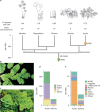Fern genomes elucidate land plant evolution and cyanobacterial symbioses
- PMID: 29967517
- PMCID: PMC6786969
- DOI: 10.1038/s41477-018-0188-8
Fern genomes elucidate land plant evolution and cyanobacterial symbioses
Abstract
Ferns are the closest sister group to all seed plants, yet little is known about their genomes other than that they are generally colossal. Here, we report on the genomes of Azolla filiculoides and Salvinia cucullata (Salviniales) and present evidence for episodic whole-genome duplication in ferns-one at the base of 'core leptosporangiates' and one specific to Azolla. One fern-specific gene that we identified, recently shown to confer high insect resistance, seems to have been derived from bacteria through horizontal gene transfer. Azolla coexists in a unique symbiosis with N2-fixing cyanobacteria, and we demonstrate a clear pattern of cospeciation between the two partners. Furthermore, the Azolla genome lacks genes that are common to arbuscular mycorrhizal and root nodule symbioses, and we identify several putative transporter genes specific to Azolla-cyanobacterial symbiosis. These genomic resources will help in exploring the biotechnological potential of Azolla and address fundamental questions in the evolution of plant life.
Conflict of interest statement
The authors declare no competing interests.
Figures





Comment in
-
Fern genomes finally here.Nat Plants. 2018 Jul;4(7):404-405. doi: 10.1038/s41477-018-0202-1. Nat Plants. 2018. PMID: 29967516 No abstract available.
Similar articles
-
Genome erosion in a nitrogen-fixing vertically transmitted endosymbiotic multicellular cyanobacterium.PLoS One. 2010 Jul 8;5(7):e11486. doi: 10.1371/journal.pone.0011486. PLoS One. 2010. PMID: 20628610 Free PMC article.
-
An ancient route towards salicylic acid and its implications for the perpetual Trichormus-Azolla symbiosis.Plant Cell Environ. 2023 Sep;46(9):2884-2908. doi: 10.1111/pce.14659. Epub 2023 Jul 2. Plant Cell Environ. 2023. PMID: 37394786
-
Comparative genomic insights into culturable symbiotic cyanobacteria from the water fern Azolla.Microb Genom. 2021 Jun;7(6):000595. doi: 10.1099/mgen.0.000595. Microb Genom. 2021. PMID: 34181515 Free PMC article.
-
Tansley Review No. 116: Cyanobacterium-plant symbioses.New Phytol. 2000 Sep;147(3):449-481. doi: 10.1046/j.1469-8137.2000.00720.x. New Phytol. 2000. PMID: 33862930 Review.
-
Azolla--a model organism for plant genomic studies.Genomics Proteomics Bioinformatics. 2003 Feb;1(1):15-25. doi: 10.1016/s1672-0229(03)01004-0. Genomics Proteomics Bioinformatics. 2003. PMID: 15626330 Free PMC article. Review.
Cited by
-
Horizontal Gene Transfer Involving Chloroplasts.Int J Mol Sci. 2021 Apr 25;22(9):4484. doi: 10.3390/ijms22094484. Int J Mol Sci. 2021. PMID: 33923118 Free PMC article. Review.
-
Genome-wide molecular evolution analysis of the GRF and GIF gene families in Plantae (Archaeplastida).BMC Genomics. 2024 Jan 18;25(1):74. doi: 10.1186/s12864-024-10006-w. BMC Genomics. 2024. PMID: 38233778 Free PMC article.
-
The C-Fern (Ceratopteris richardii) genome: insights into plant genome evolution with the first partial homosporous fern genome assembly.Sci Rep. 2019 Dec 3;9(1):18181. doi: 10.1038/s41598-019-53968-8. Sci Rep. 2019. PMID: 31796775 Free PMC article.
-
Metabolic diversification of nitrogen-containing metabolites by the expression of a heterologous lysine decarboxylase gene in Arabidopsis.Plant J. 2019 Nov;100(3):505-521. doi: 10.1111/tpj.14454. Epub 2019 Aug 27. Plant J. 2019. PMID: 31364191 Free PMC article.
-
Mesostigma viride Genome and Transcriptome Provide Insights into the Origin and Evolution of Streptophyta.Adv Sci (Weinh). 2019 Oct 24;7(1):1901850. doi: 10.1002/advs.201901850. eCollection 2020 Jan. Adv Sci (Weinh). 2019. PMID: 31921561 Free PMC article.
References
-
- Schneider H, et al. Ferns diversified in the shadow of angiosperms. Nature. 2004;428:553–557. - PubMed
-
- The Arabidopsis Genome Initiative Analysis of the genome sequence of the flowering plant Arabidopsis thaliana. Nature. 2000;408:796–815. - PubMed
-
- Hidalgo O, et al. Is there an upper limit to genome size? Trends Plant Sci. 2017;22:567–573. - PubMed

